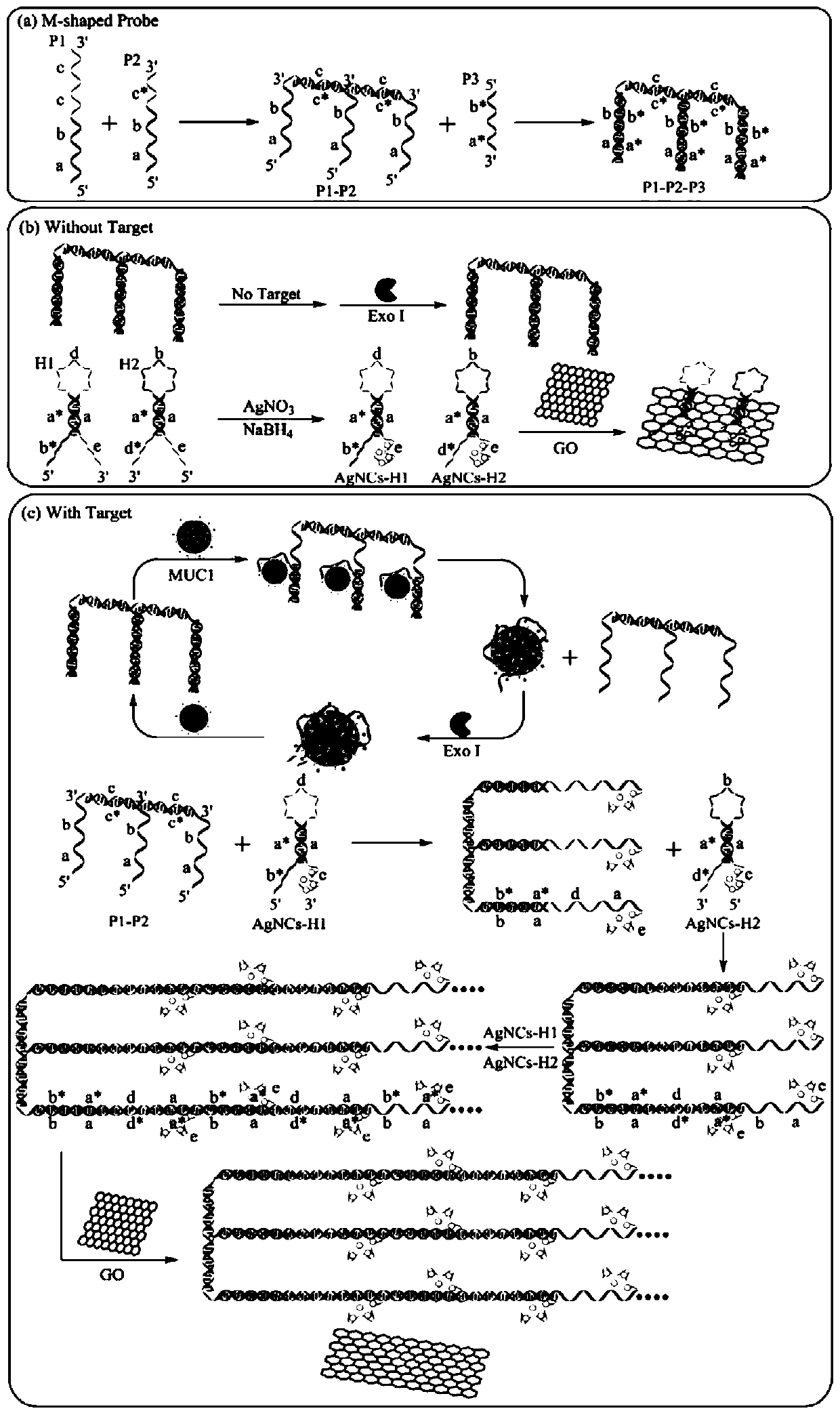Fluorescent biological probe for detecting mucin 1, sensor, application and detection method
A fluorescent bioprobe and biosensor technology, applied in the field of fluorescent bioprobes, can solve the problems of long operation time (more than 15 hours, complicated steps in the sensor preparation process, difficult to control the particle size, etc., to avoid covalent labeling, The effect of lowering the detection limit and improving the detection sensitivity
- Summary
- Abstract
- Description
- Claims
- Application Information
AI Technical Summary
Problems solved by technology
Method used
Image
Examples
Embodiment 1
[0078] The design of embodiment 1 fluorescent biological probe
[0079] The fluorescent biological probes used for mucin 1 detection provided in this example include aptamer probes and hairpin probes;
[0080] The aptamer probe is self-assembled from sequences P1, P2 and P3;
[0081] The sequence P1 sequentially includes sequence a, sequence b and at least two sequences c from the 5' end to the 3' end;
[0082] The sequence P2 sequentially includes sequence a, sequence b, and sequence c* complementary to sequence c bases from the 5' end to the 3' end;
[0083] The sequence P3 includes sequence b* complementary to the base of sequence b and sequence a* complementary to the base of sequence a from the 5' end to the 3' end; the sequence P3 is the aptamer sequence of the target, which can specifically sexual binding target;
[0084] The hairpin probes include hairpin probes H1 and hairpin probes H2;
[0085] The hairpin probe H1 comprises sequentially from the 5' end to the 3'...
Embodiment 2
[0092] Example 2 Preparation of Fluorescent Bioprobes for Mucin 1 Detection
[0093] 1. Preparation of aptamer probes
[0094] (1) The dry powders of the oligonucleotide sequences P1, P2 and P3 in Table 1 were centrifuged at 12000rpm for 5 minutes, and then dissolved in 20mM Tris-HNO 3 Buffer (containing 20mM NaNO 3 ,10mM NH 4 NO 3 ,2mM Mg(NO 3 ) 2 , pH7.4), to obtain 100 μM stock solutions respectively;
[0095] (2) Pipette 10 μL of the stock solution of sequence P1, pipette 20 μL of the stock solution of sequence P2, pipette 30 μL of the stock solution of sequence P3, and add the above-mentioned stock solution to 40 μL of reaction buffer (containing 20 mM Tris-HNO 3 ,50mM KNO 3 ,10mM Mg(NO 3 ) 2 , 1 mM DTT, pH 7.9), incubated at 37°C for 20 minutes to obtain M-shaped aptamer probes P1-P2-P3 at a concentration of 10 μM, and stored at 4°C.
[0096] 2. Preparation of fluorescent hairpin probes
[0097] (1) Centrifuge the dry powder of oligonucleotide sequence H1 at 1...
Embodiment 3
[0101] Example 3 Fluorescence biosensor for mucin 1 detection
[0102] This example provides a fluorescent biosensor for mucin 1 detection, including the aptamer probe prepared in Example 2 and fluorescent hairpin probes AgNCs-H1 and AgNCs-H2.
[0103] Further, the first reaction reagents are included, based on a total volume of 49 μL, including:
[0104] Aptamer probe, 1 μM, 5 μL;
[0105] Reaction buffer, 32 μL;
[0106] Exo I solution, 10U / μL, 2μL;
[0107] 1× Exo I buffer, 10 μL.
[0108] Further, the second reaction reagent is included, based on a total volume of 50 μL, including:
[0109] Fluorescent hairpin probe AgNCs-H1, 1 μM, 15 μL;
[0110] Fluorescent hairpin probe AgNCs-H2, 1 μM, 15 μL;
[0111] GO solution, 1 mg / mL, 20 μL.
[0112] Further, the Exo I solution contains 10U / μL of Exo I;
[0113] The 1×Exo I buffer contains 67mM glycine-KNO 3 ,6.7mM Mg(NO 3 ) 2 , and 1 mM DTT, pH9.4;
[0114] The reaction buffer contains 20mM Tris-HNO 3 ,50mM KNO 3 ,10...
PUM
 Login to View More
Login to View More Abstract
Description
Claims
Application Information
 Login to View More
Login to View More - R&D
- Intellectual Property
- Life Sciences
- Materials
- Tech Scout
- Unparalleled Data Quality
- Higher Quality Content
- 60% Fewer Hallucinations
Browse by: Latest US Patents, China's latest patents, Technical Efficacy Thesaurus, Application Domain, Technology Topic, Popular Technical Reports.
© 2025 PatSnap. All rights reserved.Legal|Privacy policy|Modern Slavery Act Transparency Statement|Sitemap|About US| Contact US: help@patsnap.com



